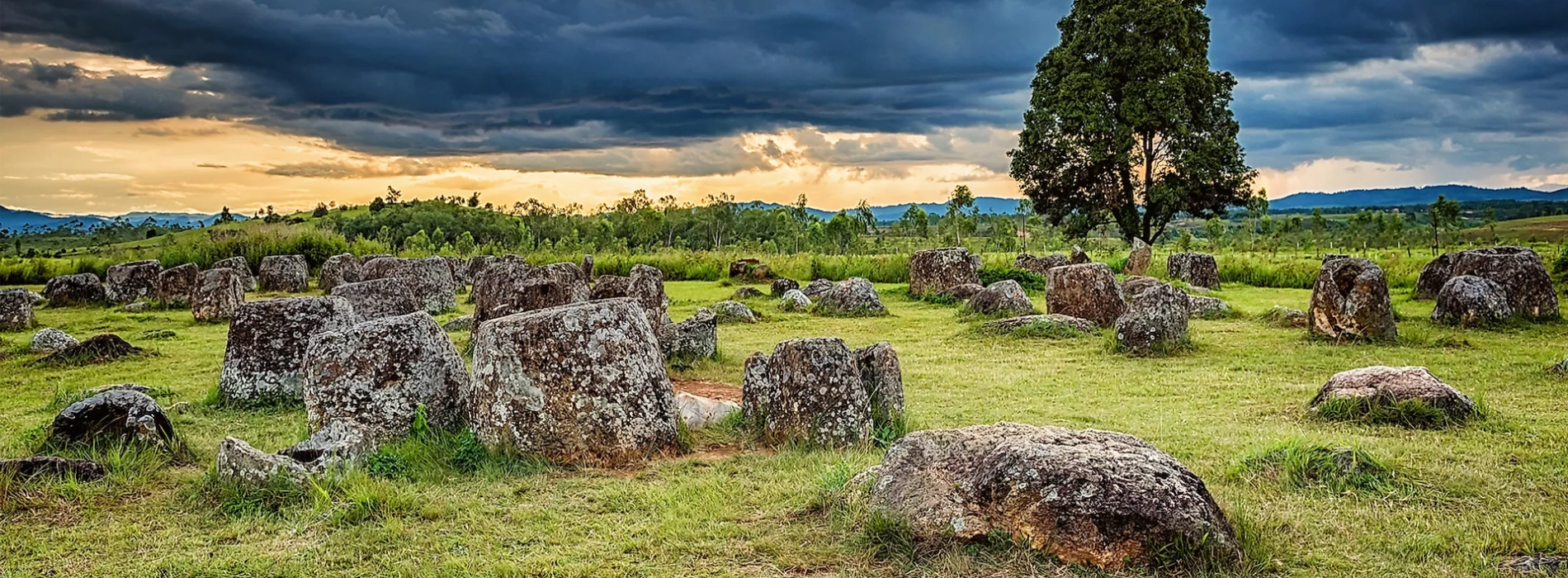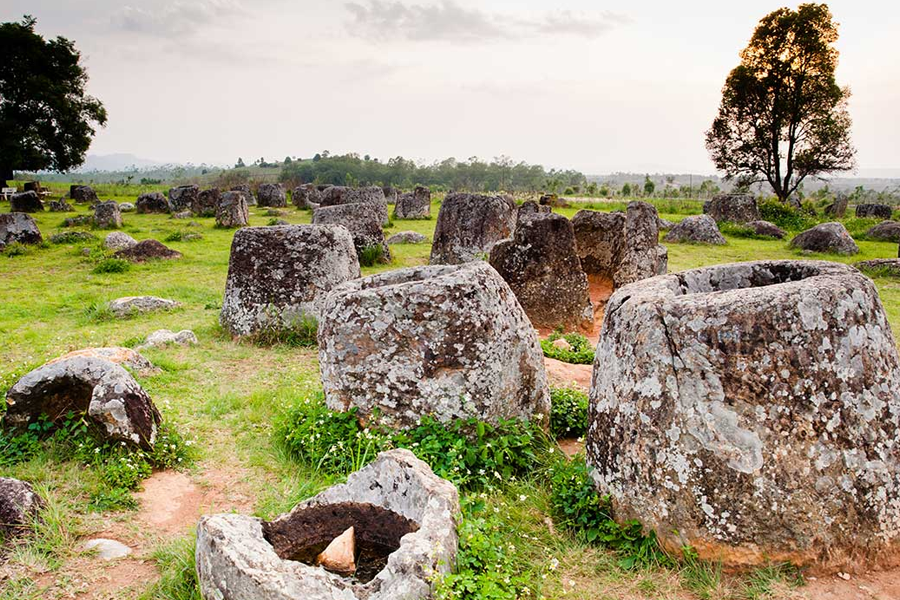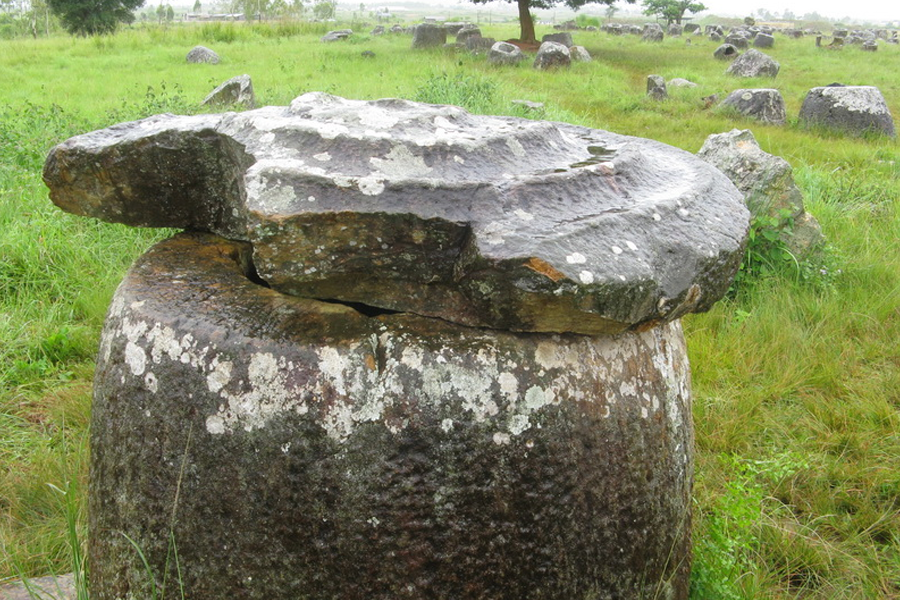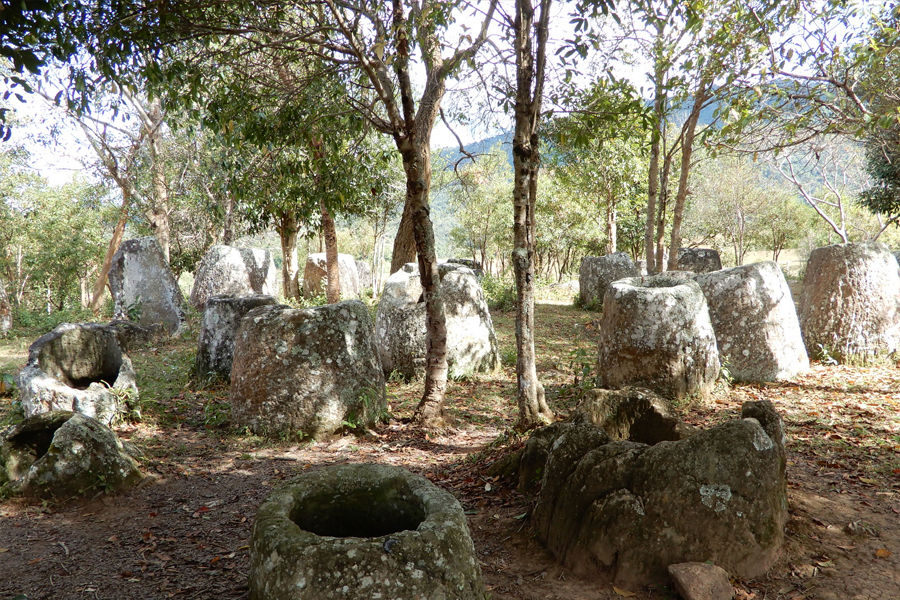
Join Asia King Travel to a land of mystery, as we embark on the journey to the wilderness of Laos to uncover the secrets of the ancient Plain of Jars, scattered across the rugged landscape.
The Plain of Jars is a unique collection of thousands of multi-sized stone jars strewn around the Xieng Khouang plain, approximately 15 kilometers southwest of Phonsavan, Xiang Khouang Province. The Plain of Jars resembles a chess board from a distance, and the jars themselves like magnificently large chess pieces.
Visitors can notice the amazing combination without any set arrangement as they get closer. While some jars are half submerged on the ground, many are fully protruding. The majority of jars weigh several tons on average and are between one and two meters tall. Although cylindrical, they differ in width and shape without any clear pattern.
The plateau is home to around 90 jar sites, each containing one to several hundred stone jars. Not all places have been made accessible to tourists due to unexploded bombs, mines, and ammunition. Only seven locations (Sites 1, 2, 3, 16, 23, 25, and 52) are deemed safe and open for visitors.

The Plain of Jars
Being among the oldest prehistoric sites in Southeast Asia, it has long puzzled Laotian and foreign researchers, with numerous tales surrounding its origins remaining a mystery.
How the massive stone jars got to be where they are today is another enigma that a lot of people are curious about. The jars may have originated from a quarry 8 kilometers away from the Plain of Jars, according to research. However, it is still a mystery that requires investigation as to how ancient societies moved heavy jars - some of which weighed up to 30 tons here.
You may also like: Uncover the mysteries of the Ancient Plain of Jars in Laos
Although the Plain of Jars is thought to have been built during the Iron Age, between 500 BC and 500 AD, the origins of the site are still unknown. The general consensus is that wandering Indian tribes discovered the Plain of Jars approximately 2,000 years ago. Another mythology claims that the highlands were home to a race of giants who, on orders of their King Khun Cheung, created jars to brew and preserve an enormous amount of Lao Lao rice wine to commemorate their victory against the enemy. According to other theories, the jars were used to store food or monsoon rainwater for the dry season.

The Plain of Jars has a mystique background
However, after finding a cave nearby that contained human remains including ash and burned bones along with ceramics and burial artifacts, archeologists surmised that the stone jars were actually urns and had something to do with prehistoric funeral customs. To this day, there are still no concrete explanations for the origin of the jars. Whatever the origin of the field of jars may be, the mystery behind it further allures tourists far and wide to come and visit the site.
Although seven sites are open to visitors, the first three are the most popular among tourists to discover while visiting Plain of Jars. The daily opening hours are 9 a.m. to 5 p.m., and each location charges an entrance fee of between 10,000 - 15,000 kip (0,48 - 0,72 USD) per person.
Site 1, also known as “Thong Hai Hin”, which translates to “Stone Jar Plain”, is one of the largest sites with over 300 jars. It is also the most visited site, being the closest to the town of Phonsavan.
At the entrance is a community handicraft store as well as a visitor center with history and information about Plain of Jars, including its significance during the Second Indochina War.
Site 1 boasts several distinctive features that combine to provide a type of one-stop shop for all the noteworthy aspects of the Plain of Jars. These include the largest jar (weighing over 10 tons and standing almost 3 meters tall), the only jar containing a lid on it, engraved jars, and a sizable cave that is believed to be an old crematorium. There are also trenches, foxholes and bomb craters that are reminiscences of the Laotian Civil War in the 1960s.

Site 1 of Plain of Jars, where the only jar with a lid up top can be found
Site 2 is located a bit further from Phonsavan, and the quality of the path there is not exactly smooth, with the road usually in a shabby condition. However, if tourists manage to get through it, an interesting adventure awaits.
Site 2 is divided in half by the road, with one side differing from the other. On one side, jars are perched atop a tiny hill and offer striking views of the plains; on the other, jars are sheltered behind a small copse of trees and offer a more private, clandestine atmosphere.
Here, a large number of the jars exhibit damage from roots caused by time and natural forces, while some have been totally split in half by their nearby forests. This location is less crowded with tourists, allowing visitors to feel more "green" and closer to these amazing historical sites. It also boasts a more picturesque hilltop perspective of the plains below and rice paddies.
Site 3 is quite similar to site 2 and is also surrounded by a small group of trees. To visit Site 3, there is a 30-minute walk from Site 2 through the village of Ban Xiengoy.
Compared to site 1, these jars are less conventional and more rectangular in shape, with some being so tall that visitors cannot see the inside. Visitors should carefully observe the little stone markings put in place by the Mine Advisory Group (MAG) to ensure their safety. These markers are meant to serve as a reminder that the area has been cleared of unexploded ordnance and is safe.

Plain of Jars Site 3
To get to Plain of Jars, tourists first need to get to the town of Phonsavan.
From there, you can get to Plain of Jars by renting bikes, motorbikes, or cars. Depending on quality, a bike costs from 20,000 kip (0.96 USD) per day while it takes about 100,000 kip (4,78 USD) per day for a motorbike. Depending on the rental business, a four-wheel-drive vehicle may cost between 50 and 80 USD, including or excluding gasoline. Prices may change based on availability and season.
On the route to Site 1, the roads are in decent shape, so you can rent a bike or a motorcycle. However, do travel with additional caution as the roads to Sites 2 and 3 are of lower quality.
In short, the Plain of Jars is a testament to Laos’ rich cultural heritage and ancient history. Despite centuries of speculation and research, the true purpose and origin of these fascinating stone jars remain a mystery, adding to their allure and mystery. If you have the chance to visit Laos, do explore this fascinating place!
You may also like: Xieng Khouang Tour 3 Days: Discover the Plain of Jars